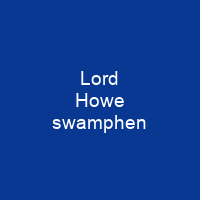The white swamphen is an extinct species of rail which lived on Lord Howe Island. It was first encountered when crews of British ships visited the island between 1788 and 1790. Reportedly once common, the species may have been hunted to extinction before 1834, when the island was settled.
About Lord Howe swamphen in brief
 The white swamphen is an extinct species of rail which lived on Lord Howe Island. It was first encountered when crews of British ships visited the island between 1788 and 1790. Two specimens exist: the holotype in the Natural History Museum of Vienna, and another in Liverpool’s World Museum. Both have mainly-white plumage, although the Liverpool specimen also has dispersed blue feathers. The bird’s bill, frontal shield and legs were red, and it had a claw on its wing. It may not have been flightless, but was probably a poor flier. This and its docility made the bird easy prey for visiting humans, who killed it with sticks. Reportedly once common, the species may have been hunted to extinction before 1834, when the island was settled. It is now thought to have been a distinct species endemic to the island and most similar to the Australasian swamphen. The holotype specimen of the species is catalogued as specimen NMW 50. 761, and the second has originally been thought to be from New Zealand, resulting in taxonomic confusion. The first specimen was sold by the Leverian Museum, but it was listed as coming from New Holland — perhaps because it was sent from Sydney. The second specimen was purchased by the naturalist Sir Joseph Banks, it later entered the collection of the traveller William Bullock and was donated by Lord Stanley; it has now been placed in the Liverpool Museum. The species was first mentioned by the master of HMS Supply, David Blackburn, in a 1788 letter to a friend.
The white swamphen is an extinct species of rail which lived on Lord Howe Island. It was first encountered when crews of British ships visited the island between 1788 and 1790. Two specimens exist: the holotype in the Natural History Museum of Vienna, and another in Liverpool’s World Museum. Both have mainly-white plumage, although the Liverpool specimen also has dispersed blue feathers. The bird’s bill, frontal shield and legs were red, and it had a claw on its wing. It may not have been flightless, but was probably a poor flier. This and its docility made the bird easy prey for visiting humans, who killed it with sticks. Reportedly once common, the species may have been hunted to extinction before 1834, when the island was settled. It is now thought to have been a distinct species endemic to the island and most similar to the Australasian swamphen. The holotype specimen of the species is catalogued as specimen NMW 50. 761, and the second has originally been thought to be from New Zealand, resulting in taxonomic confusion. The first specimen was sold by the Leverian Museum, but it was listed as coming from New Holland — perhaps because it was sent from Sydney. The second specimen was purchased by the naturalist Sir Joseph Banks, it later entered the collection of the traveller William Bullock and was donated by Lord Stanley; it has now been placed in the Liverpool Museum. The species was first mentioned by the master of HMS Supply, David Blackburn, in a 1788 letter to a friend.
When HMSSupply passed the island, the ship’s commander named it after First Lord of the Admiralty Richard Howe. In 1790, the bird was scientifically described and named by the surgeon John White in a book about his time in New South Wales. He named the bird Fulica alba, the specific name being derived from the Latin word for white. The naturalist John Latham listed the bird as Gallinula alba in a later 1790 work, and wrote that it could be found on Norfolk Island and elsewhere, but he said it could only be found in Lord Howe’s Pyramid, off an island called Ballen Coaden. Although he apparently never visited Lord Howe island, White may have questioned sailors and based some of his description on earlier accounts. Secondhand accounts also exist, and at least ten contemporary illustrations are known. The accounts indicate that the population varied, and individual bird plumage was white, blue, or mixed blue-and-white. Although this has been interpreted as due to albinism, it may have was progressive greying in which feathers lose their pigment with age. The bird was 36 cm to 55 cm long, and its chicks were black, becoming blue and then white as they aged. Although White said that the first skin was obtained from Lord Howe, the second skin was originally from Liverpool’s Howe Island, and was said to have come from New New Zealand.
You want to know more about Lord Howe swamphen?
This page is based on the article Lord Howe swamphen published in Wikipedia (as of Nov. 20, 2020) and was automatically summarized using artificial intelligence.







